SpringBoot 源码解析 —— SpringApplication 源码分析
点击上方 " Java指南者 "关注, 星标或置顶一起成长
免费送 1024GB 精品学习资源
正常的 SpringBoot 应用程序
一个正常的 SpringBoot 项目的启动类中常见代码如下:
@SpringBootApplication
public class SpringbotApplication {
public static void main(String[] args) {
SpringApplication.run(SpringbotApplication.class, args);
}
}
上面的代码也就两个比较引人注意的地方:
-
@SpringBootApplication
-
SpringApplication.run()
对于 SpringBootApplication 注解不在本文讲解,本文主要讲解一下 SpringApplication 类的 run 方法,这个 run 方法是一个静态的方法,其实内部是进行构造 SpringBootApplication 对象,然后调用了 run 方法。
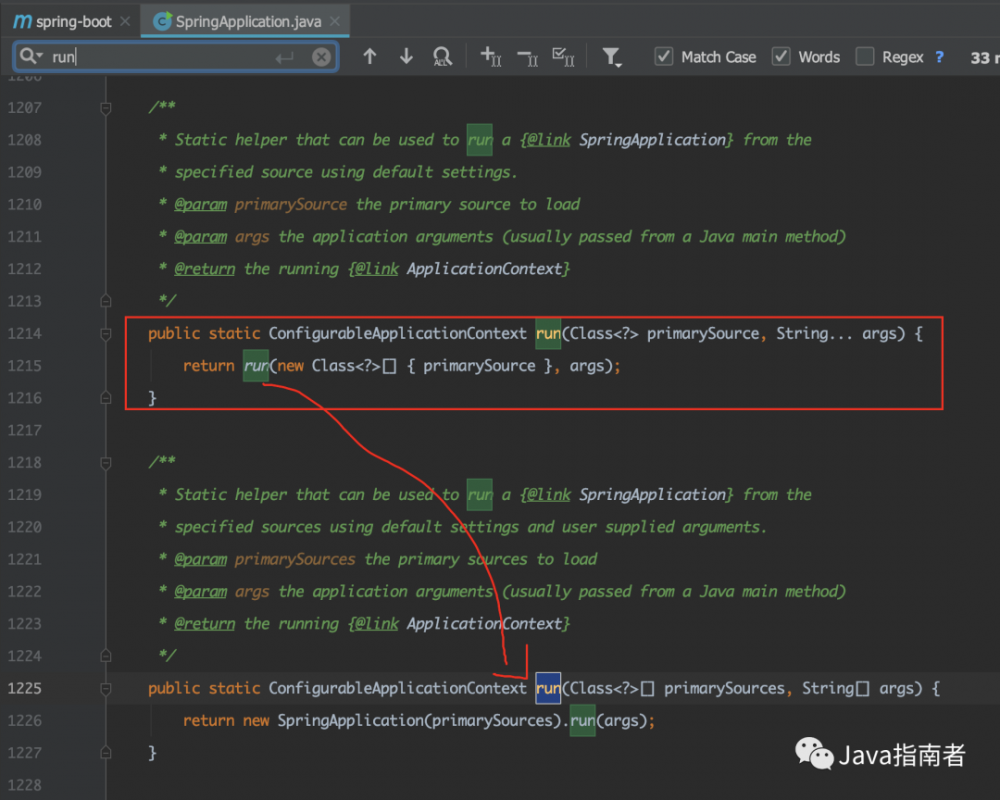
所以其实你像下面这样写代码也是可以的:
@SpringBootApplication
public class SpringbotApplication {
public static void main(String[] args) {
SpringApplication app = new SpringApplication(SpringbotApplication.class);
// 自定义应用程序的配置
//app.setXxx()
app.run(args)
}
}
SpringApplication 构造器
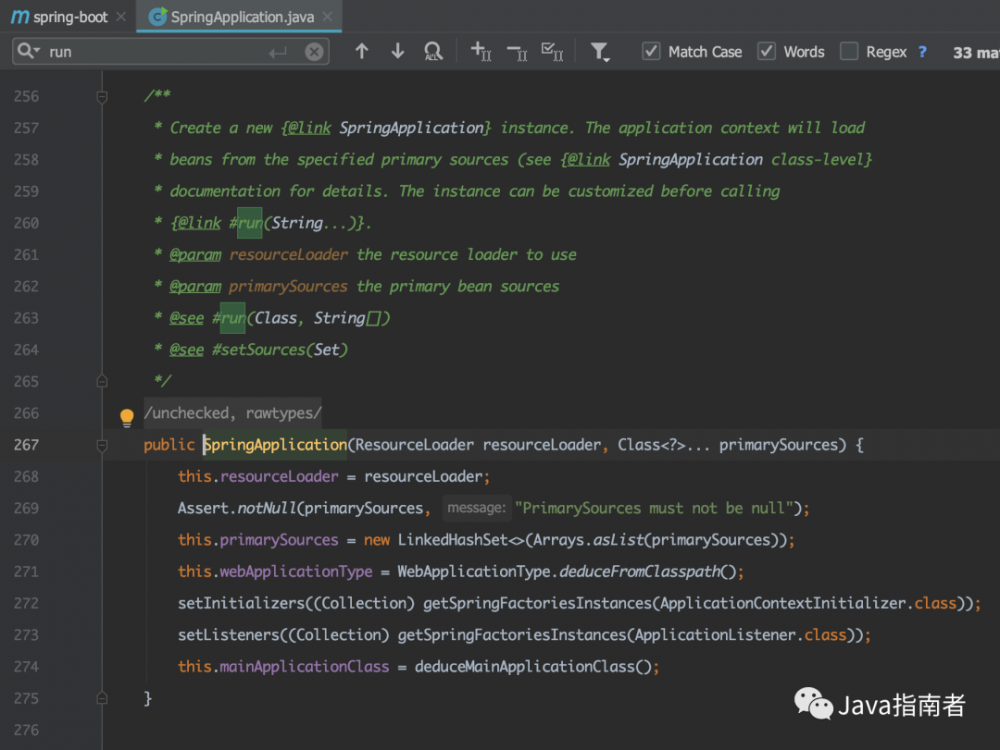 该构造方法中会创建一个 SpringApplication 实例,应用上下文会根据指定的资源加载 beans,在调用 run 方法之前可以自定义该实例。
该构造方法中会创建一个 SpringApplication 实例,应用上下文会根据指定的资源加载 beans,在调用 run 方法之前可以自定义该实例。
-
resourceLoader:资源加载器
-
primarySources:启动类
-
webApplicationType:应用类型,有 _NONE、SERVLET、REACTIVE _三种类型,通过 deduceFromClasspath 函数进行判断
//通过反射判断
static WebApplicationType deduceFromClasspath() {
if (ClassUtils.isPresent(WEBFLUX_INDICATOR_CLASS, null) && !ClassUtils.isPresent(WEBMVC_INDICATOR_CLASS, null)
&& !ClassUtils.isPresent(JERSEY_INDICATOR_CLASS, null)) {
return WebApplicationType.REACTIVE;
}
for (String className : SERVLET_INDICATOR_CLASSES) {
if (!ClassUtils.isPresent(className, null)) {
return WebApplicationType.NONE;
}
}
return WebApplicationType.SERVLET;
}
-
ApplicationContextInitializer :初始化 classpath 下的所有的可用的 ApplicationContextInitializer
setInitializers((Collection) getSpringFactoriesInstances(ApplicationContextInitializer.class));
private <T> Collection<T> getSpringFactoriesInstances(Class<T> type) {
return getSpringFactoriesInstances(type, new Class<?>[] {});
}
private <T> Collection<T> getSpringFactoriesInstances(Class<T> type, Class<?>[] parameterTypes, Object... args) {
ClassLoader classLoader = getClassLoader();
// Use names and ensure unique to protect against duplicates
Set<String> names = new LinkedHashSet<>(SpringFactoriesLoader.loadFactoryNames(type, classLoader));
List<T> instances = createSpringFactoriesInstances(type, parameterTypes, classLoader, args, names);
AnnotationAwareOrderComparator.sort(instances);
return instances;
}
在 getSpringFactoriesInstances 方法中会通过 SpringFactoriesLoader.loadFactoryNames()
加载所有的 ApplicationContextInitializer,该类方法是 spring-core 里面的代码了,它会先根据类加载器从 cache 中找是否加载过,否则会通过类加载器去加载 META-INF/spring.factories
文件中的 ApplicationContextInitializer。
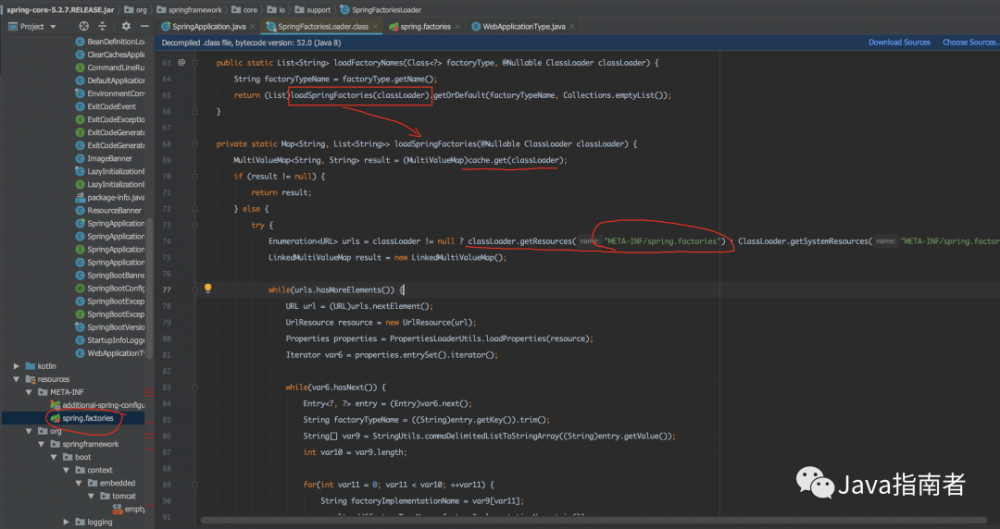
来看下 META-INF/spring.factories
文件中的内容:
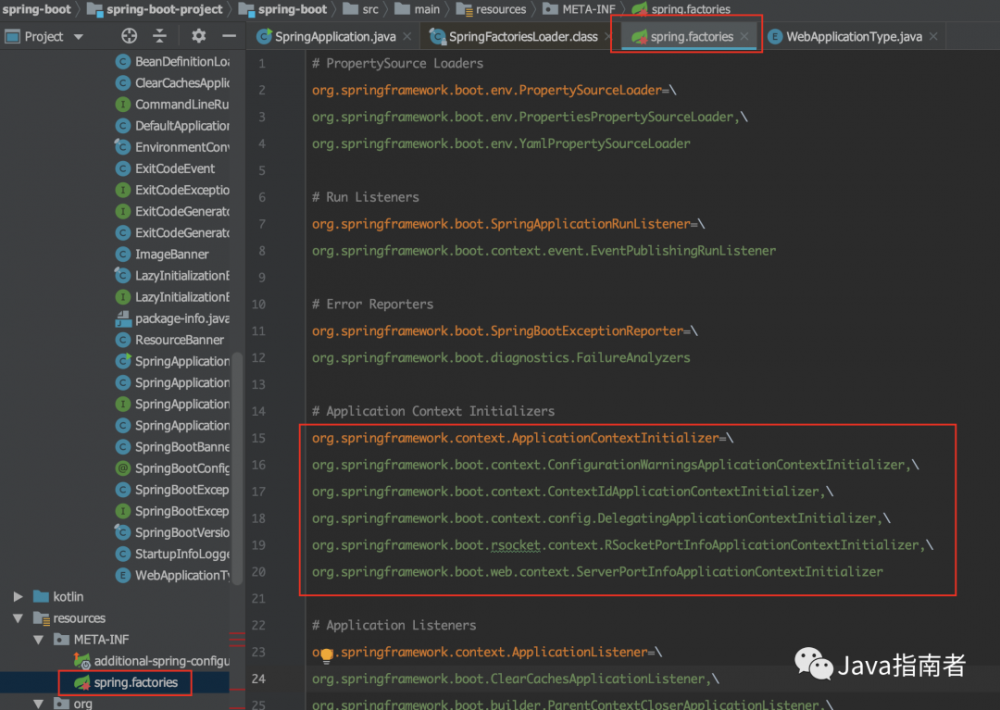
应该就是去加载找上图标记中的 Application Context Initializers 。
找到的结果如下图所示:

找到这些 ApplicationContextInitializer 后需要做的是创建 spring 工厂实例:
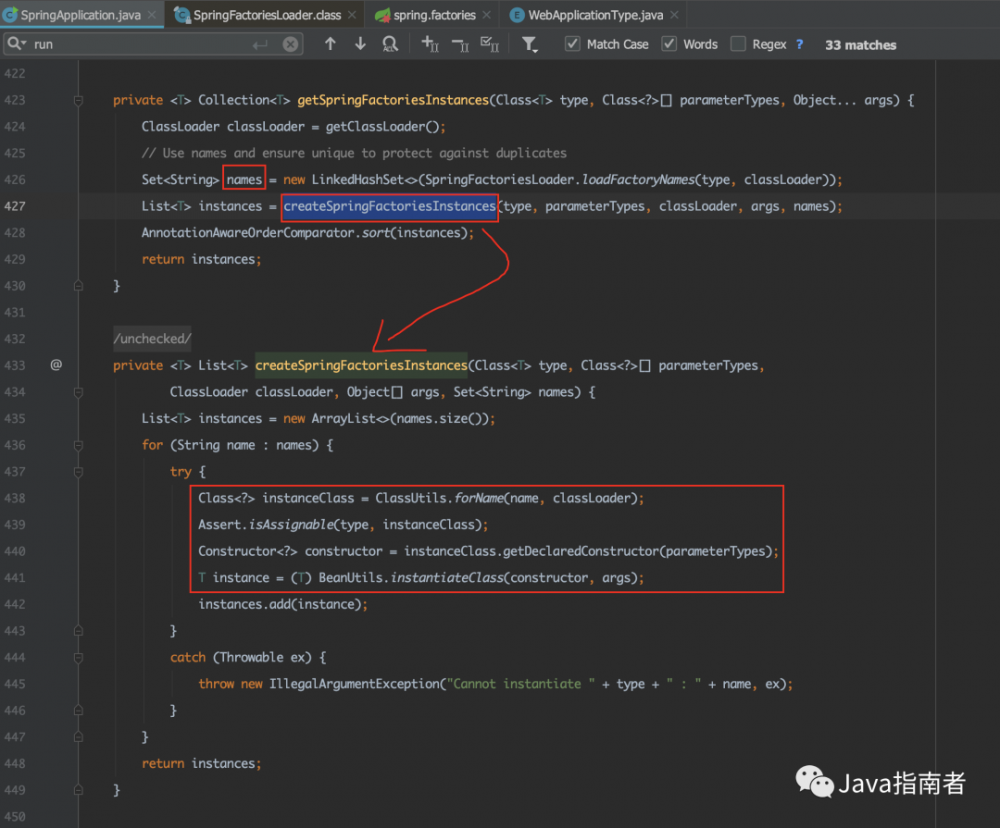
-
ApplicationListener:初始化 classpath 下的所有的可用的 ApplicationListener
这个和上面的初始化 classpath 下的所有的可用的 ApplicationContextInitializer 是一样的,也是通过一样的方式去加载 META-INF/spring.factories
文件中所有的 Application Listeners,文件内容如下:
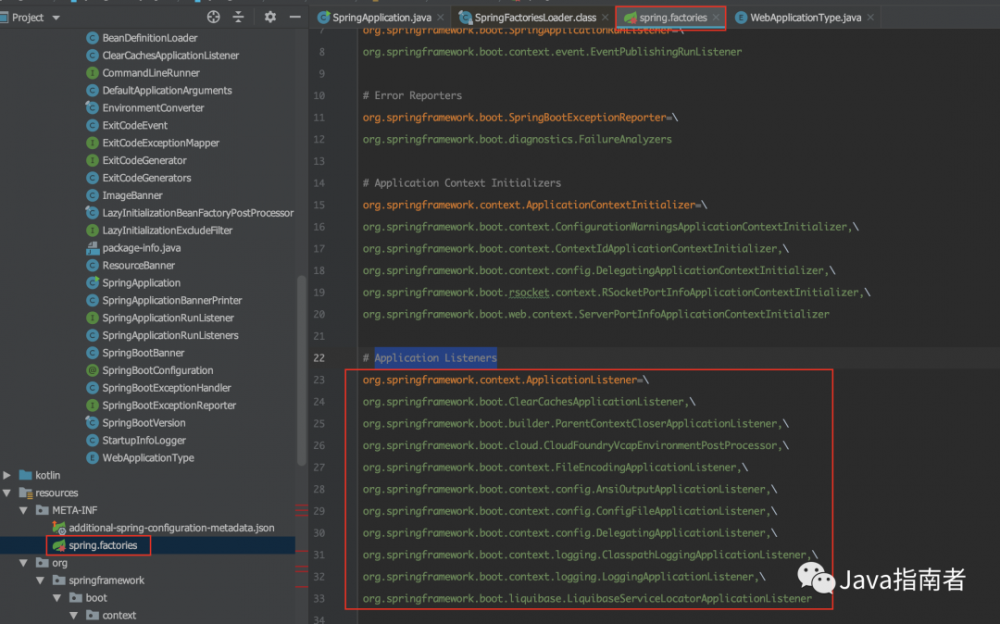
找到的结果如下图所示:
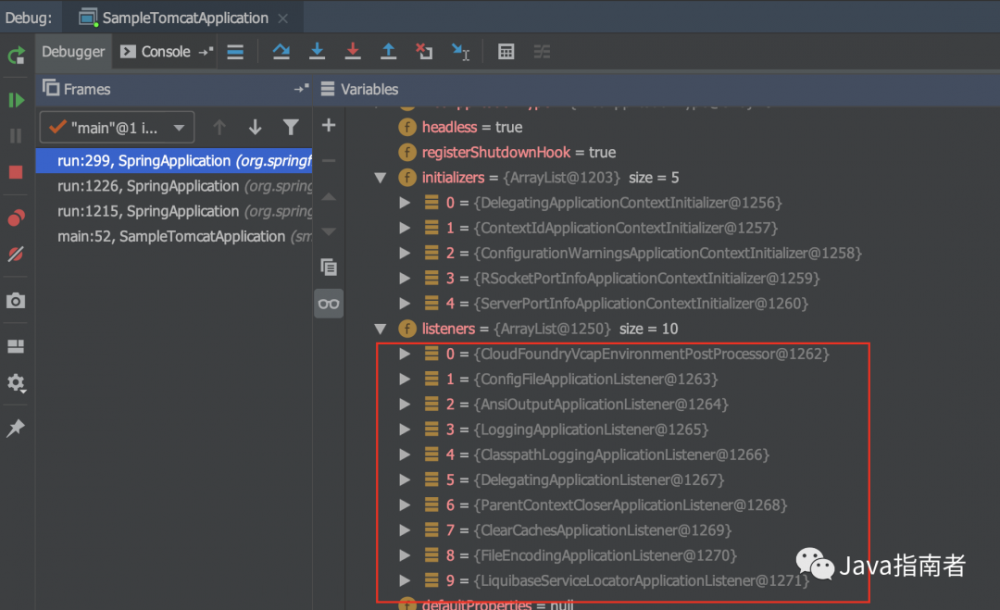
-
mainApplicationClass:找到带有 main 方法的主类名称
run 方法
run 方法上面的注释的意思大概是说:启动 Spring 应用程序,创建和更新一个 ApplicationContext 。
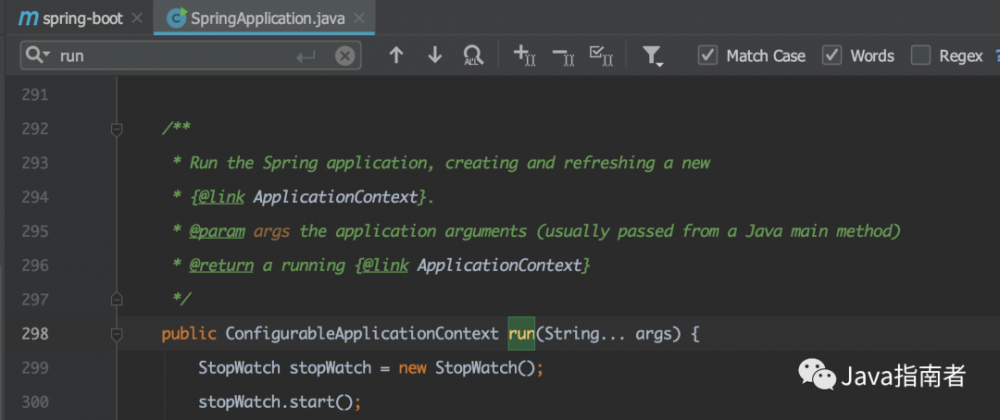
看看方法中的具体代码:
public ConfigurableApplicationContext run(String... args) {
StopWatch stopWatch = new StopWatch();
stopWatch.start();
ConfigurableApplicationContext context = null;
Collection<SpringBootExceptionReporter> exceptionReporters = new ArrayList<>();
configureHeadlessProperty();
SpringApplicationRunListeners listeners = getRunListeners(args);
listeners.starting();
try {
ApplicationArguments applicationArguments = new DefaultApplicationArguments(args);
ConfigurableEnvironment environment = prepareEnvironment(listeners, applicationArguments);
configureIgnoreBeanInfo(environment);
Banner printedBanner = printBanner(environment);
context = createApplicationContext();
exceptionReporters = getSpringFactoriesInstances(SpringBootExceptionReporter.class,
new Class[] { ConfigurableApplicationContext.class }, context);
prepareContext(context, environment, listeners, applicationArguments, printedBanner);
refreshContext(context);
afterRefresh(context, applicationArguments);
stopWatch.stop();
if (this.logStartupInfo) {
new StartupInfoLogger(this.mainApplicationClass).logStarted(getApplicationLog(), stopWatch);
}
listeners.started(context);
callRunners(context, applicationArguments);
}
catch (Throwable ex) {
handleRunFailure(context, ex, exceptionReporters, listeners);
throw new IllegalStateException(ex);
}
try {
listeners.running(context);
}
catch (Throwable ex) {
handleRunFailure(context, ex, exceptionReporters, null);
throw new IllegalStateException(ex);
}
return context;
}
我们挑该方法中比较重要的进行讲解:
-
getRunListeners:该方法利用和上面一样的加载方法会去读取 classpath 下的 SpringApplicationRunListeners
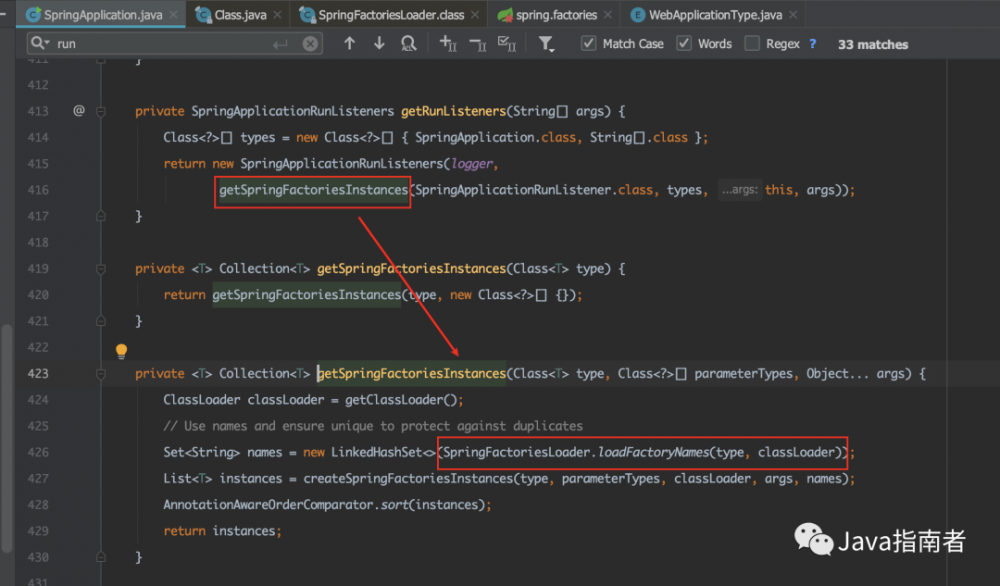
在 META-INF/spring.factories
文件中的 SpringApplicationRunListener 有:
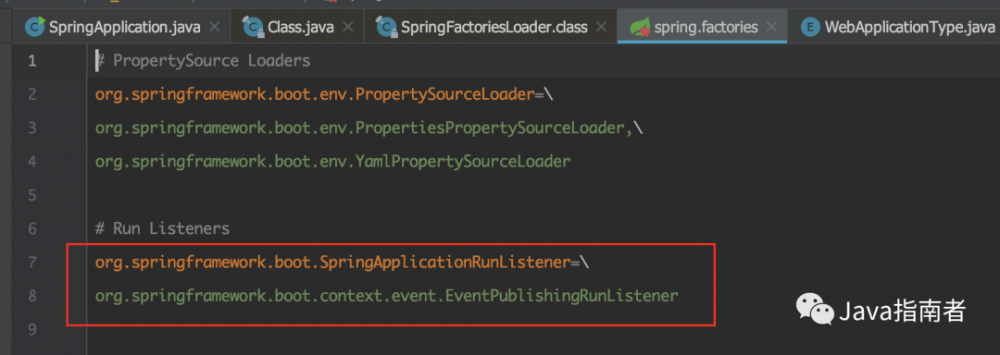
该 listener 只负责 run 方法的监听
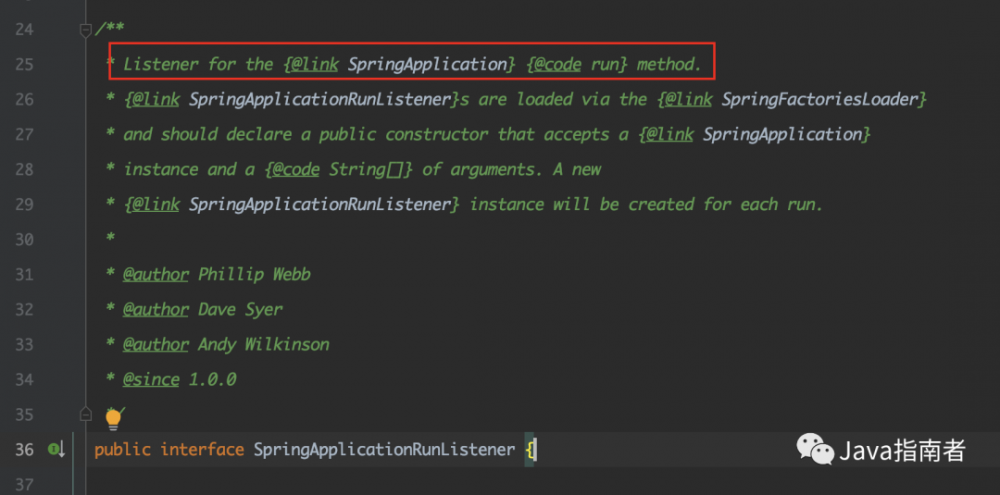
它的状态有下面几种:
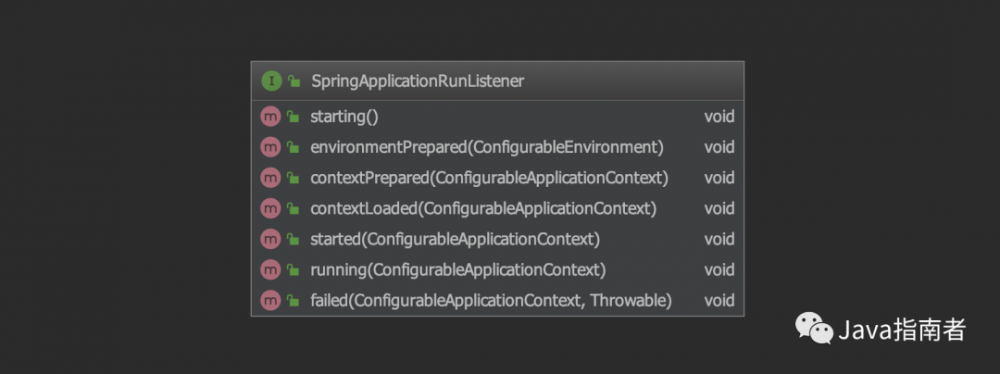
-
prepareEnvironment:根据 listeners 和 applicationArguments 配置 SpringBoot 应用的环境
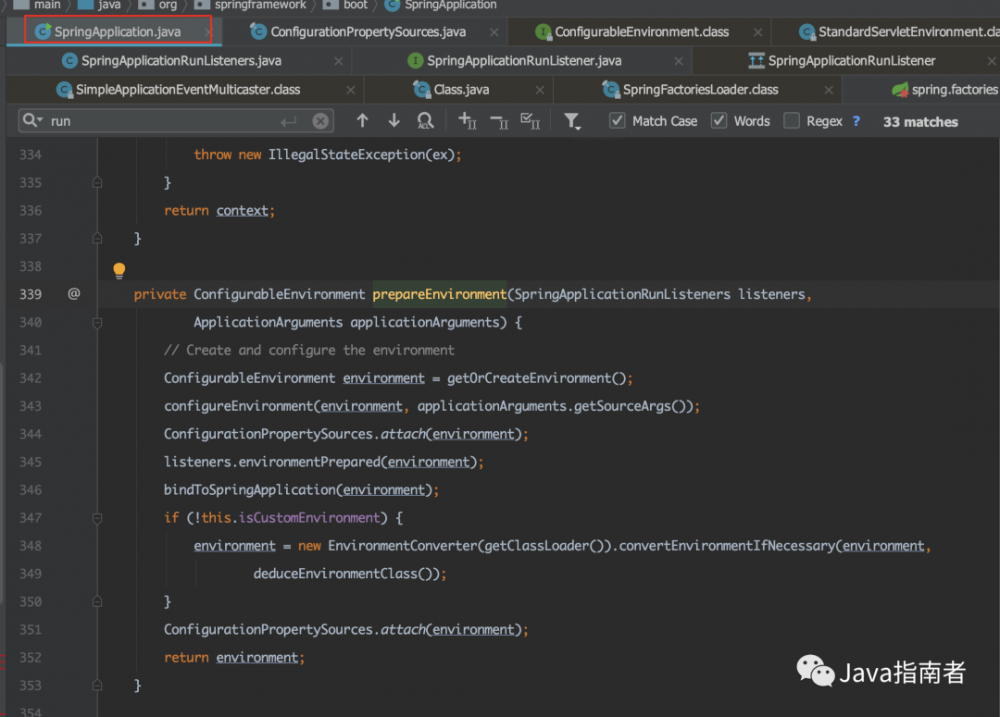
-
configureIgnoreBeanInfo:根据环境信息配置要忽略的 bean 信息

-
printBanner:打印 spring boot 的标志,可以自定义
-
createApplicationContext:根据应用类型来确定该 Spring Boot 项目应该创建什么类型的 ApplicationContext ,默认情况下,如果没有明确设置的应用程序上下文或应用程序上下文类,该方法会在返回合适的默认值
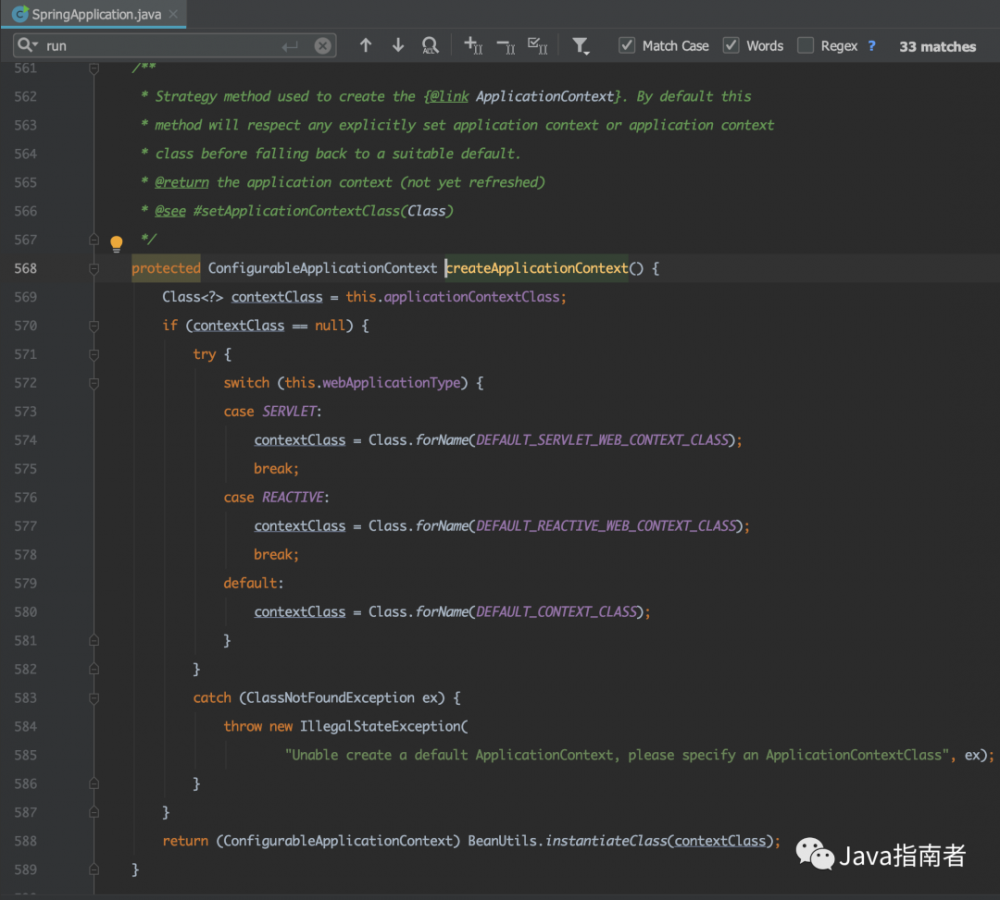 然后又用到了反射,可以看到目前为止,代码也是大量使用的 Java 中的反射。
然后又用到了反射,可以看到目前为止,代码也是大量使用的 Java 中的反射。
-
get SpringBootExceptionReporter:也是通过 getSpringFactoriesInstances 方法获取到 classpath 下的 SpringBootExceptionReporter
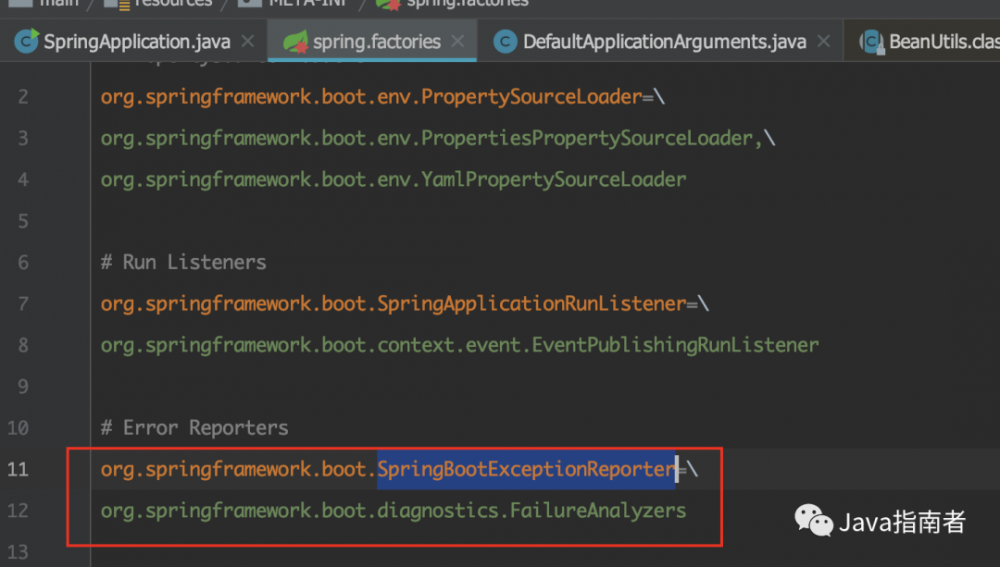
从到目前的代码可以发现,在 SpringBoot 里面大量使用了这种 SPI 加载机制。
-
prepareContext:完成整个容器的创建与启动以及 bean 的注入功能
private void prepareContext(ConfigurableApplicationContext context, ConfigurableEnvironment environment,
SpringApplicationRunListeners listeners, ApplicationArguments applicationArguments, Banner printedBanner) {
context.setEnvironment(environment);
postProcessApplicationContext(context);
applyInitializers(context);
listeners.contextPrepared(context);
if (this.logStartupInfo) {
logStartupInfo(context.getParent() == null);
logStartupProfileInfo(context);
}
// Add boot specific singleton beans
ConfigurableListableBeanFactory beanFactory = context.getBeanFactory();
beanFactory.registerSingleton("springApplicationArguments", applicationArguments);
if (printedBanner != null) {
beanFactory.registerSingleton("springBootBanner", printedBanner);
}
if (beanFactory instanceof DefaultListableBeanFactory) {
((DefaultListableBeanFactory) beanFactory)
.setAllowBeanDefinitionOverriding(this.allowBeanDefinitionOverriding);
}
if (this.lazyInitialization) {
context.addBeanFactoryPostProcessor(new LazyInitializationBeanFactoryPostProcessor());
}
// Load the sources
Set<Object> sources = getAllSources();
Assert.notEmpty(sources, "Sources must not be empty");
load(context, sources.toArray(new Object[0]));
listeners.contextLoaded(context);
}
postProcessApplicationContext 该方法对 context 进行了预设置,设置了 ResourceLoader、ClassLoader 和 ConversionService,并向 bean 工厂中添加了一个 beanNameGenerator 。
applyInitializers 方法将刚才获取到的所有 ApplicationContextInitializer 进行初始化。
listeners.contextPrepared(context) 对所有的 SpringApplicationRunListeners 进行创建和准备应用上下文,在加载资源之前调用。
load(context, sources.toArray(new Object[0])) 主要是加载各种 beans 到 ApplicationContext 对象中。
contextLoaded 方法会将所有的应用上下文进行加载。
-
refreshContext:更新应用上下文,最后是调用下面该方法
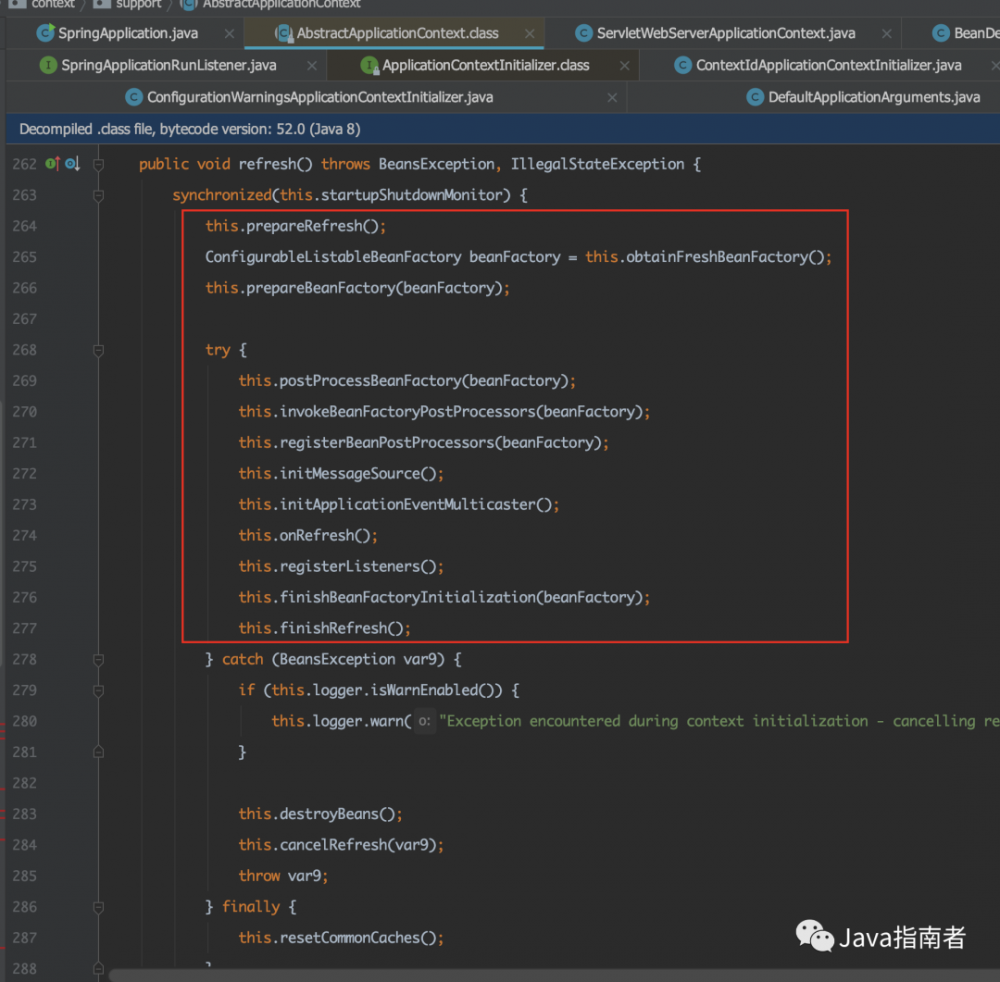
-
afterRefresh(): 在上下文刷新后调用该方法,其内部没有做任何操作
-
listeners.started(context): 应用上下文更新了,应用也开启了,但是 _CommandLineRunner _和 _ApplicationRunner _还没有调用
-
callRunners:ApplicationRunner 和 CommandLineRunner 进行回调
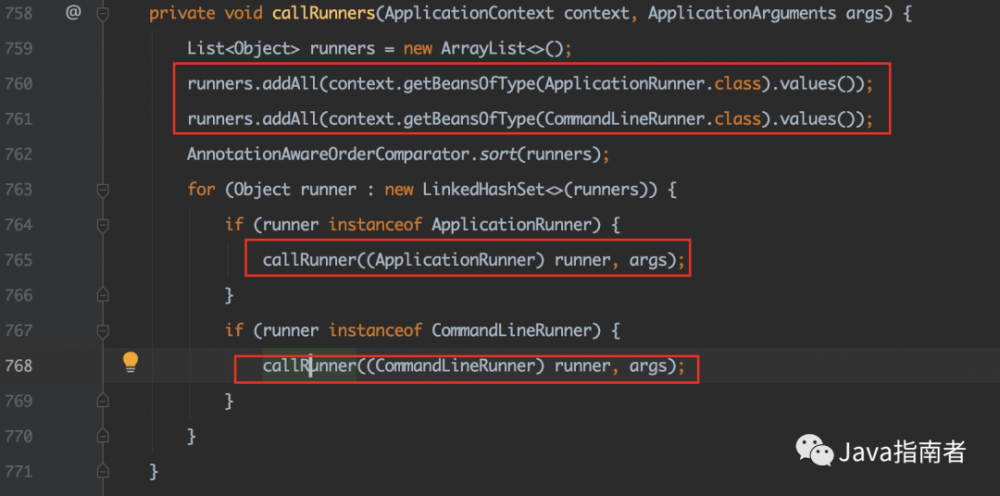
-
listeners.running(context):接着就是改变状态为 running 了
整个 run 方法中的 SpringApplicationRunListeners 的状态变更顺序 如下:
可以发现 SpringApplicationRunListeners 这个类已经在 run 方法里面有经过 6 次的状态变更,那么它所有的状态有哪些呢?我们来一起瞧瞧:

还有一种就是当出现异常的时候,就会 failed,这个是在 catch 里面会做状态变更的。
关注我
关注我,Java 学习不迷路!

- 本文标签: Property servlet ArrayList CEO core ssl IO cat 解析 BeanDefinition db springboot 注释 src web cache tar HashSet HTML Listeners tab Spring Boot 代码 list java bean 类加载器 App 免费 源码 id UI Java指南 spring Service https 构造方法 CTO http classpath Collection 配置 实例
- 版权声明: 本文为互联网转载文章,出处已在文章中说明(部分除外)。如果侵权,请联系本站长删除,谢谢。
- 本文海报: 生成海报一 生成海报二











![[HBLOG]公众号](https://www.liuhaihua.cn/img/qrcode_gzh.jpg)

